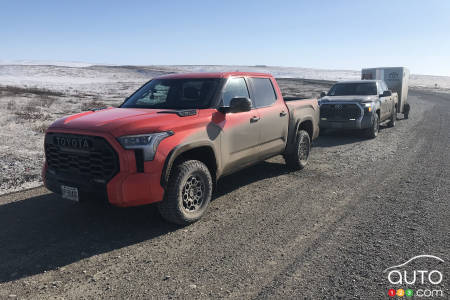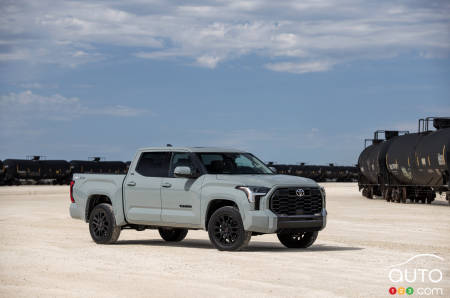
Auto123 drove to Canada's far north in a 2022 Toyota Tundra. Today, the second part of our unique test drive.
See also: Traversing the Canadian Tundra in a 2022 Toyota Tundra: An Atypical Review, Part 1
See also: 2022 Toyota Tundra Review: The Rebirth
Over 5500 km on various roads...
Our adventure behind the wheel of the Tundras began in Vancouver. Actually, it really started a few miles south in Tacoma, Washington. The idea was to use that as a starting point because of the name associated with Toyota's other pickup, the Tacoma. There were five of us in the two Tundras: myself, Ontario journalist Howard Elmer, head of the Truck King group, his two sons Stephen and Matthew, both of whom are participants in Truck King's YouTube reports, and renowned cameraman Danny Bailey, whose work regularly appears on TV shows in Canada.
The first part of our trip took us through and past the Vancouver area, a portion we used to record some of the fuel-consumption figures of the trucks. As you can see, the hybrid Tundra did well in this environment, the electric motor allowing us to save fuel (both engines in these Tundras run on regular-octane gas, by the way). Of course, the size of such a large vehicle could and did present certain challenges in urban situations, but those didn’t amount to anything insurmountable.
Browse cars for sale available near you
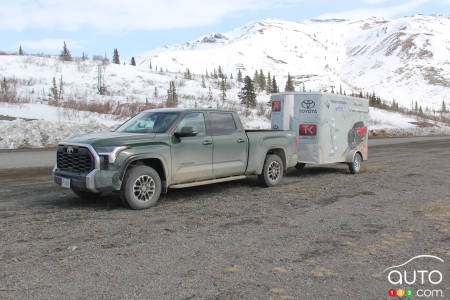
Leaving the Vancouver area in our rearview mirror, we attacked the highways of British Columbia, including Highway 99, direction north. Driving mostly on beautiful roads skirting the Rockies, we were able to register some of our stingiest fuel-consumption numbers, in some cases with the help of the adaptive cruise control.
This exercise allowed us to confirm just how much more fuel-efficient the V6 engines are than the 5.7L V8 they’ve replaced. What's more, they outperformed it, with, for example, 0-100 km/h acceleration doable in less than 7 seconds with two occupants on board (without the trailer). I especially appreciated the passing capabilities with this powertrain.
The TRD Pro with the hybrid engine was certainly the faster of the two trucks, but the Tundra with the twin-turbo engine was capable of surprisingly smooth acceleration. As for the trailer, it was barely noticeable behind either of the trucks.
Early on in the trip, the vehicle pulling the trailer, the SR5, could only manage 31.4L/100 km. We were in the mountains and even the hybrid version could do no better than 18.3L/100 km. However, the next day, in flatter terrain (we’d entered the part of British Columbia with pasture plains), the same SR5 managed an average of 20.6L/100 km with the trailer. Note that at this point, I was using cruise control a much as practical. The orange Tundra was down to 13.7L/100 km (though without the trailer).
We arrived on Day Four in Whitehorse, where we detached the trailer and transferred it to the Tundra hybrid. On flat ground, it gave us a fuel consumption of 14.0L / 100 km, but as soon as we got back to more mountainous terrain, the truck got greedier, to the tune of 24.0L and 21.9L/100 km, registered at our two refuelling stops. The twin-turbo Tundra remained stable at 12.7L / 100 km during the day's three refuelings (which entailed covering 1,300 km of road).
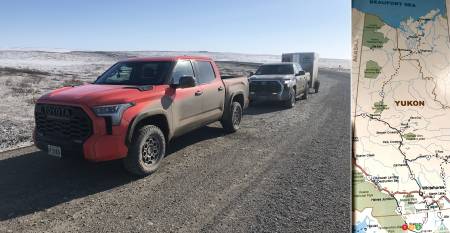
The famous Dempster Highway!
It was on Day Five that the trip really changed. From Whitehorse, we headed for the iconic Dempster Highway. If you’ve never heard of this road, you should know that it is one of the most spectacular routes in the world. The Dempster Highway is a dirt and gravel road that sits on top of a gravel bed over a meter deep that in turn sits on top of permafrost. We drove mostly at more than 120 km/h for some 800 km before reaching reach the only truck stop on this wild road, in Eagle Plains.
The landscape at this stage is beautiful but disconcerting, disturbing almost. It goes gradually from the forest dotted with small conifers to a land of very stunted trees. The dust raised by the vehicle in front of us forced us to keep a certain distance. The road surface was relatively even, but the front vehicle driver used radio communication to warn the second of the condition of the road and of the vehicles coming towards them, especially heavy vehicles. The TRD Pro's suspension provided respectable handling, as it is designed for off-road excursions with more travel at the start.
The Tundra SR5 also handles very well but is a bit stiffer. However, neither rear axle moves sideways over road imperfections like a pickup truck with leaf spring rear suspension would. Fortunately, despite the many rocks that hit the windshield, neither vehicle suffered any significant damage.
The most difficult part of the trip was the section from Eagle Plains to Tuktoyaktuk, over 517 km away via Fort McPherson and Inuvik. This far north, there’s no more vegetation, only plains and hills of snow. We had to cross two “ice bridges” (more than eight feet thick); these are managed and monitored by the government, which rated them for vehicles with loads of up to 64,000 kg!
On Day Seven our trip, we were finally at the Arctic Ocean, the Beaufort Sea in front of us frozen seven feet deep; open water can only be seen forty km from the shore.

The return
From Tuktoyaktuk, it was time to turn the vehicle around for the drive back to Inuvik and Eagle Plains. Having crossed the ice bridges again, we felt relieved and safer (and especially, free from the (small) possibility) of having to spend several weeks in the region before the ferries returned to service for the season).
First observation: Our Tundras held up with little damage. While several interested folks we met along the way (and there were several) warned us that we could suffer more than one flat tire, our Falken and Bridgestone tires held up! The trailer, however, showed all kinds of damage. The front end was pockmarked with dents from flying rocks, the fenders had been bent by larger rocks, the footstep had been ripped off and both tires were severely worn due to a bent axle.
From Inuvik to Whitehorse, we still had to cover more than 1,400 km (including a small detour to Dawson City for some photos and more "touristy" filming for reports that can be seen on YouTube under the name Truck King).
Despite the fact that they were “prototype” trucks, the Toyota Tundra SR5 and TRD Pro proved to be very reliable travel vehicles. As it happened, we had Mother Nature on our side, so much so that the four-wheel-drive function was only called upon on one occasion.
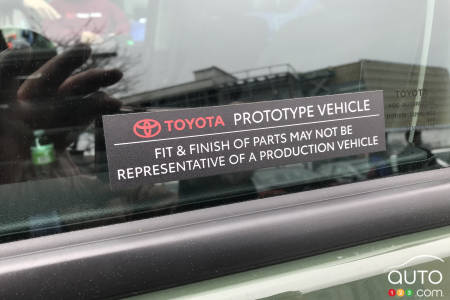
As far as prices are concerned, remember that these were prototypes, but everything seems to indicate that our green SR5 pickup would have had a price point amounting to $58,681, while the orange TRD Pro would be worth some $82,000 on the market.
Our journey showed us that Toyota has fashioned its pickup truck more for tourism than for work. The Japanese-born automaker seems to be satisfied with the 100,000 or so units its Texas plant can produce each year. Clearly, Toyota isn't trying to compete with U.S. manufacturers that produce between 700,000 and one million pickups a year (almost a quarter of which are Class 2 and 3 work versions, which Toyota doesn't offer).
Toyota fans will be well served by these new Tundras. However, one wonders if the brand will be able to survive the new wave of pickups that are about to hit – and possibly transform the market. I’m referring of course to all-electric pickups. One question this begs is, Is the new hybrid version of the 2022 Tundra up to date or already outdated? Time will tell.
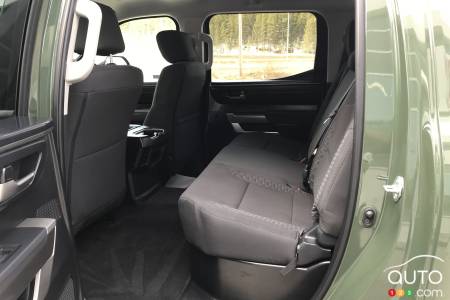
We like
More reasonable fuel consumption than the old V8
Improved handling on rough roads
Remarkable performance of the hybrid version
We like less
Lack of front hooks
Difficult access to the body
No automatic transfer case function
Specifications sheet 2022 Toyota Tundra






